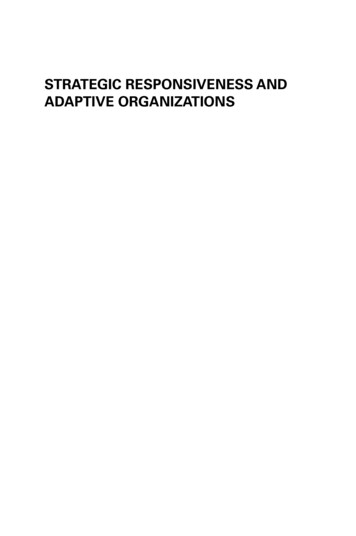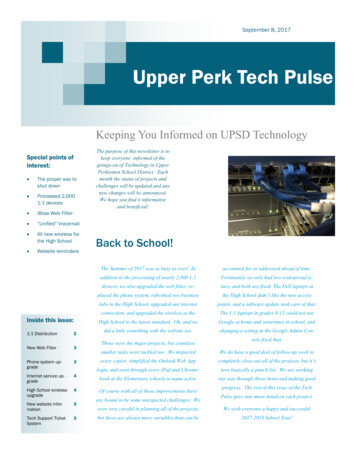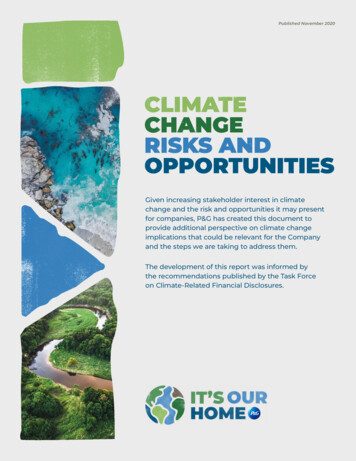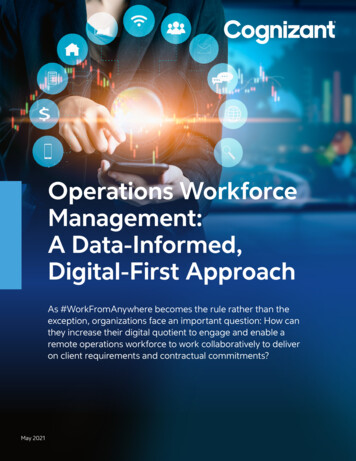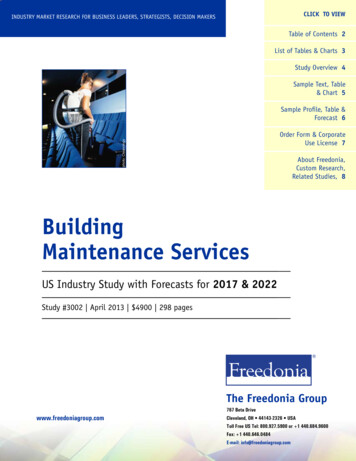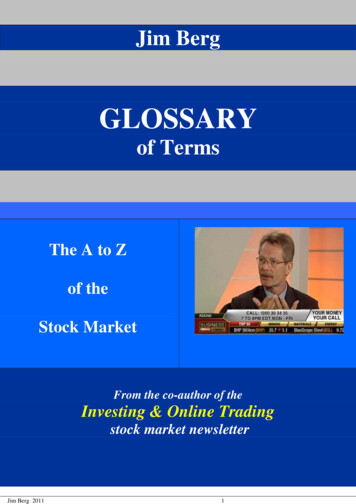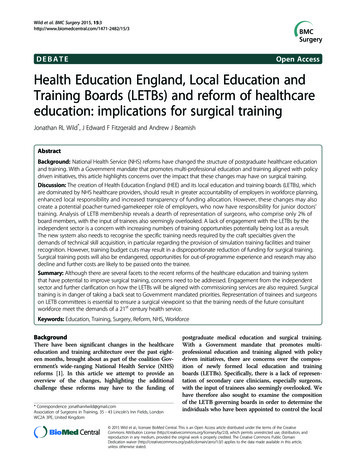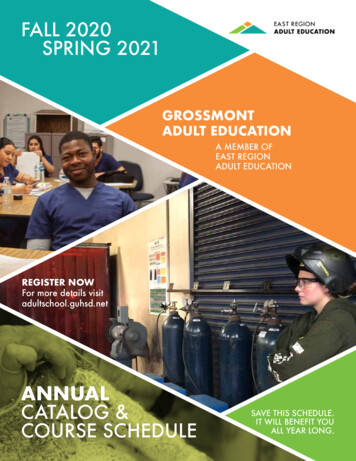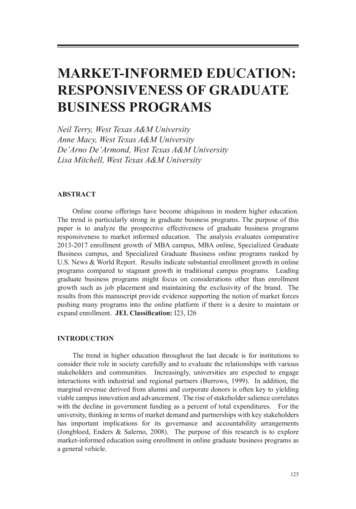
Transcription
MARKET-INFORMED EDUCATION:RESPONSIVENESS OF GRADUATEBUSINESS PROGRAMSNeil Terry, West Texas A&M UniversityAnne Macy, West Texas A&M UniversityDe’Arno De’Armond, West Texas A&M UniversityLisa Mitchell, West Texas A&M UniversityABSTRACTOnline course offerings have become ubiquitous in modern higher education.The trend is particularly strong in graduate business programs. The purpose of thispaper is to analyze the prospective effectiveness of graduate business programsresponsiveness to market informed education. The analysis evaluates comparative2013-2017 enrollment growth of MBA campus, MBA online, Specialized GraduateBusiness campus, and Specialized Graduate Business online programs ranked byU.S. News & World Report. Results indicate substantial enrollment growth in onlineprograms compared to stagnant growth in traditional campus programs. Leadinggraduate business programs might focus on considerations other than enrollmentgrowth such as job placement and maintaining the exclusivity of the brand. Theresults from this manuscript provide evidence supporting the notion of market forcespushing many programs into the online platform if there is a desire to maintain orexpand enrollment. JEL Classification: I23, I26INTRODUCTIONThe trend in higher education throughout the last decade is for institutions toconsider their role in society carefully and to evaluate the relationships with variousstakeholders and communities. Increasingly, universities are expected to engageinteractions with industrial and regional partners (Burrows, 1999). In addition, themarginal revenue derived from alumni and corporate donors is often key to yieldingviable campus innovation and advancement. The rise of stakeholder salience correlateswith the decline in government funding as a percent of total expenditures. For theuniversity, thinking in terms of market demand and partnerships with key stakeholdershas important implications for its governance and accountability arrangements(Jongbloed, Enders & Salerno, 2008). The purpose of this research is to exploremarket-informed education using enrollment in online graduate business programs asa general vehicle.125
The organization of the manuscript includes a background section framing theenvironment influencing market-informed education. The second section puts forthinformation relating to the rise and efficacy of online delivery in higher education.The third section offers a brief empirical analysis illustrating a perspective on theimportance of responsiveness to market demand in higher education via graduatebusiness program enrollment trends. The final section offers a conclusion with adiscussion on research extensions and limitations.BACKGROUNDInterconnections and interdependencies between higher education, society, andthe economy is a salient aspect of the modern market. Higher education is interactingwith an increased number and variety of stakeholders. How a university proceedsto identify, prioritize, and engage with its communities reflects the evolution of theuniversity. One may argue that the outcome of this process of stakeholder engagementwill have cogent implications for the university’s chances for survival (Jongbloed,Enders & Salerno, 2008). Understanding universities as complex social agents is key,not just to build more efficiently functioning universities, but also for identifying theunintended consequences and possible pitfalls that may emerge through the adoptionof new market approaches.The stakeholder concept originates from the business science literature (Freeman,1984) tracing back to Adam Smith’s “The Theory of Moral Sentiments.” Its modernuse in management literature comes from the Stanford Research Institute introducingthe term in 1963 to generalize the notion of the stockholder as to the only group orindividual to whom management need be responsive. A more modern definition ofstakeholder is “any group or individual who can affect or is affected by the achievementof the firm’s objectives” (Freeman, 1984). Freeman argues that business organizationsshould be concerned about their stakeholders’ interest when making strategic choices.Higher education institutions have a distinctly public character or responsibilityto society (Neave, 2000). To meet this public responsibility objective, higher educationinstitutions historically receive significant funding from government sources. Today,the basic funding and functions that higher education institutions perform aregoing through a process of change. The teaching and research functions are beingreassessed, with an eye upon the contribution they make to the social-economic wellbeing of their environment. Higher education is not only expected to deliver excellenteducation and research, but it also must deliver those outputs in ways and forms thatare relevant to the productive process and to shaping the knowledge of society. Asfar back as 1973, there were discussions about changing the social contract betweenhigher education and society (International Labor Organization, 1975). In additionto the transmission and extension of knowledge, universities have been called uponto engage the following: (1) Play an important role in the general social objective ofachieving greater equality of opportunity; (2) Provide education adapted to a greatdiversity of individual qualifications, motivations, and aspirations; (3) Facilitate theprocess of lifelong learning; and (4) Assume a public service function by makinga contribution to the solution of major problems faced by the local community andsociety at large (Neave, 2006).The current market environment forces universities to be in constant dialogue126
with their stakeholders in society. This may lead to some fundamental changes in therelationship linking the universities and their industry environment. In their educationand research tasks, universities continue to have an obligation to demonstratequality, efficiency, and effectiveness, not just to those in government administration,which have the legal and historic responsibility for exercising official oversight, butincreasingly to a wider range of stakeholders (Trow, 1996). As the source of revenueto fund institutional budgets increasingly rely directly on students, alumni, communityand corporate sources, accountability to said stakeholders expands. As the direct roleof government financial support is displaced by other stakeholders, the universitybecomes more integrated into society and more responsive to market forces. Valuein terms of enrollment but also societal support migrates to the providers that bestrespond to this change in stakeholder environment (Slywotzky, 1995). The downsideof this trend is the potential of universities becoming fragmented and overburdened bystakeholder claims unless they employ careful management practices.Faculty and staff play an important role in relation to market-informed educationas the heart of an institution. A dedicated staff is crucial to the daily customer serviceoperational components of the institution. The faculty represents the talent embodyingthe product of higher education. Facilities, athletics, and local amenities may influencestudent college selection, but academic programs cannot sustain relevance withoutcommitted faculty members. The rise of the information age and online instructionwill result in some academic programs expanding market share and other academicprograms struggling to compete. To borrow from the finance literature, beta valuestied to academic program enrollment variability will be much higher than historicalnorms. As a result, institutions continue to meet short-run enrollment expansion witha disproportionate number of non-tenure-track faculty positions relative to new tenuretrack positions. In addition, programs that struggle to compete in the modern marketreality of higher education will need to replace some retiring and departing facultywith non-tenure track positions. Tenure is a valuable part of the governance of highereducation and will be maintained into the future. On that basis, the percentage of facultyin tenured and tenure-track positions must slightly decrease to maintain flexibility tomarket demand fluctuations across various disciplines. Somewhat related, the nationalpropensity in higher education is to employ an increasing number of part-time facultyas a vehicle to support short-run growth patterns (Monks, 2009). Although manypart-time faculty members provide great value to an institution, focusing on fillingthe excess demand with full-time positions align better with the student-centeredenvironment ideology espoused by many institutions. The dedication and focusput forth by full-time faculty are a luxury many part-time faculty members cannotprovide given the need to work other jobs to earn a living (Glenn, 2016). Regardlessof designation as tenured, tenure-track, part-time, or full-time, market conditions havea significant influence on the emerging roles of faculty and staff members in highereducation.Students are the most important stakeholder for a public institution of highereducation. The existence of the institution is predicated on serving the human capitalneeds of emerging constituents that will serve as future leaders in a variety of rolesthroughout society. Higher education has witnessed transformational changes, whichincludes serving a working adult population via night classes and the more recentinnovations in the form of online course offerings. The asynchronous mode of onlineinstruction has significantly changed higher education throughout the last twenty127
years. More importantly, the trend toward online and hybrid instruction is likelyto continue for the next twenty years. Consistent with e-commerce and cyber salesdisplacing significant market share from brick and mortar retail outlets, the market foronline instruction has still not reached maturation. The transformation of dynamicengagement via video, virtual reality, augmented reality, and related tools requiressignificant and consistent investment into the online infrastructure. The modernstudent has never known life without the Internet. On the horizon, few future studentswill have ever experienced the Internet in any other form other than broadband, inmany cases complete with multiple mega or gigabyte download per second deliveryspeeds. No longer does this student visit a video store to rent movies or video games.Network television, as well as radio and music, are being replaced by on-demandviewing and listening services, and today’s students enjoy these amenities in massquantity. Further, current end-user experiences across technology platforms are greatlyenhanced via the breach and inclusion of the reality-virtuality continuum (Milgram1994). The result is an environment where the traditional dictated time and placecontinuum for higher education instruction will not serve the expectations or possiblyeven the technology-rich needs of many future students. Future students are likely todemand an increasing amount of asynchronous options, digital recreations of real-lifesettings, and virtual elements as an overlay of the real world across blended multipleengaging platforms. Institutions, programs, and disciplines that can meet those needsand expectations at a competitive price will have a market advantage in an increasinglycompetitive environment.THE ONLINE ENVIRONMENT IN BUSINESS EDUCATIONOnline course offerings in postsecondary schools are growing rapidly.Postsecondary institutions offering online courses include both traditional institutionsand institutions founded to offer only online courses. According to the U.S. Departmentof Education, 90 percent of degree-granting postsecondary institutions offeredasynchronous Internet courses in 2001 (National Center for Education Statistics,2001). Both the numbers of postsecondary schools offering online courses and thenumbers of students enrolling in online courses are increasing. Jeff Seaman, chiefinformation officer and survey director of the Sloan Consortium states, “Accordingto Online Nation: Five Years of Growth in Online Learning, the growth rate of 9.7percent for online enrollments far exceeds the growth rate of 1.5 percent for the overallhigher education student population” (Allen & Seaman, 2007). Brown and Corkill(2007) indicate that almost two-thirds of colleges and universities that offer face-toface courses also are providing graduate courses via the online environment. In recentyears, online enrollment continues to grow as the total number of students in collegeshrinks (Schaffhauser, 2017; Straumsheim 2017).As the numbers of students enrolled in online instruction have increased,researchers have debated the effectiveness of online instruction (Bowman, 2003; Fann& Lewis, 2001; Fortune, Shifflett & Sibley, 2006; Gayton & McEwen, 2007; Jennings& Bayless, 2003; Lezberg, 1998; Marks, Sibley & Arbaugh, 2005; Worley & Dyrud,2003). Interest in the effectiveness of online instruction as a component of overallprogram effectiveness has been driven by the federal government through requirementsof regional accrediting agencies, an international accreditation association for schools128
of business, universities where schools of business are housed, and varied individualstakeholders. As an individual college CEO examines the role of online learning inmeeting a college’s strategic needs, assurance of its effectiveness in the creation ofgenuine learning is a critical factor in the evaluation process (Ebersole, 2008). Whilethe need for assessment is not new, the focus of assessment as illustrated by theAssociation to Advance Collegiate Schools of Business (AACSB) International hasintensified (Pringle & Michel, 2007). All collegiate business programs are tasked withthe ongoing need for assessment (Bagamery, Lasik & Nixon, 2005; Martell & Calderon,2005; Trapnell, 2005). It is important that assessment for online education be viewedas a system that involves more than just testing and evaluation of students (Martell,2007). Traditionally, accrediting bodies were focusing primarily on input measures(Peach, Mukherjee & Hornyak, 2007). Input measures could reflect characteristicsof the students who attended the business program (Mirchandani, Lynch & Hamilton,2001) or organizational factors such as the institution’s reputation, faculty-studentratio, or the number of faculty with terminal degrees (Peach, Mukherjee & Hornyak,2007). For collegiate business programs aspiring to meet or maintain the standardsof accreditation established by AACSB, assessment requires that the schools ofbusiness have program learning goals and utilize direct measures that reflect studentdemonstration of achievement of these goals (Pringle & Michel, 2007). As schoolsof business have developed and rapidly expanded their online course enrollments,assuring that student learning in the online format is at least equivalent to the level oflearning taking place in traditional classroom courses have been a useful componentof meeting assessment requirements (Terry, 2007).Market-informed education decisions respond to traditional market forces.Online education reduces the traditional barrier to entry of geography. What were onceregional markets have become national markets or at least, larger regional markets.In this environment, branding becomes a key revenue driver as schools compete forenrollment. The increased potential market coincides with a decrease in governmentfunding. Between 2012 to 2017, government funding to higher education decreased atan annualized rate of 0.5% (Sayler, 2017). Not only have fixed costs of facilities andfaculty for universities not decreased over this period but the technology infrastructurecosts to provide innovative online instruction has increased to meet the expectations ofstudents. Schools navigate in an industry of pressured margins with limited ability toraise price because of the expanded regional marketplace. Many industries respond tothis mature market phenomenon by merging to gain the benefits of economies of scale.While this could be an option for universities, expanding enrollment through onlineprograms has the same impact of increasing quantity and lowering average fixed costper student (Grant Thornton, 2017). A key driver in expanding enrollment is branding(Sayler, 2017). Students look for accreditation, ranking, and other quality measurescombined with career enhancement opportunities in their analysis of educationalproviders. Adjusting program offerings and interactions to student needs is part ofthe expanded assessment process of including the student voice in a school’s strategicplanning response to market-informed education decisions (Higdon, 2016).Quality metrics are an important link to growing online enrollment in graduatebusiness programs. While business degree programs are offered at a wide rangeof price points, external rankings and accreditation are important quality controlconsiderations for many students. If academic programs can provide students qualityprogram combined with the convenience of the online mode, some institutions should129
benefit from the emerging market demand.EMPIRICAL ILLUSTRATIONTo illustrate the importance of responsiveness to market demand in highereducation, this section offers a brief empirical analysis of graduate business programgrowth. Online course offerings have become ubiquitous in modern higher education.The trend is particularly strong in graduate business programs. This section evaluatescomparative 2013-2017 enrollment growth of MBA campus, MBA online, SpecializedGraduate Business campus, and Specialized Graduate Business online programsranked in the top 100 (U.S. News & World Report, 2017). U.S. News & World Reportprovides annual rankings of top programs. As part of the ranking process, extensivedata is collected across multiple degree programs traits relating to admissions,enrollment, demographics, job placement, faculty credentials, and related qualitycontrol considerations.The Kruskal-Wallis test is sensitive to differences among means in the kpopulations and is extremely useful when the alternative hypothesis is that the kpopulations do not have identical means. The null hypothesis is that the k enrollmentgrowth in the different program classifications come from an identical distributionfunction. For a complete description of the Kruskal-Wallis test, see Conover (1980).The specific equations used in the calculations are as follows:(1) N Σini with i 1 to k(2) Ri ΣjR(Xij) with j 1 to ni(3) Rj ΣiOij Ri with i 1 to c(4) S2 [1/(N-1)] [Σi ti Ri2 – N(N 1)2/4] with i 1 to c(5) T (1/S2) [Σi(Ri2/ni) – N(N 1)2/4] with i 1 to k(6) (Ri/ni) – (Rj/nj) t1-a/2 [S2(N-1-T)/(N-k)]1/2 [(1/ni) (1/nj)]1/2,where R is the variable rank and N is the total number of observations. The firstthree equations find average ranks. Equation (4) calculates the sample variance, whileequation (5) represents the test statistic. If, and only if, the decision is to reject thenull hypothesis, equation (6) determines multiple comparisons of enrollment growthacross graduate business program classifications.The nonparametric empirical approach yields an equation (5) test statistics of22.36 (p-value .0001), indicating a significant difference in the average rank order ofenrollment growth across one or more of the four classifications. Assuming an alphalevel of .05, the empirical results from equation (6) indicate there are three groupingsof program classifications with enrollment growth rates that are statistically different.Specifically, the results from equations five and six provide empirical evidence thatthe MBA online has statistically higher enrollment growth rates than the other threeprogram classifications. The second highest enrollment growth is from SpecializedGraduate Business online, which is also statistically greater than the other two programclassifications. Finally, the lowest enrollme
2013-2017 enrollment growth of MBA campus, MBA online, Specialized Graduate Business campus, and Specialized Graduate Business online programs ranked by U.S. News & World Report. Results indicate substantial enrollment growth in online programs compared to stagnant growth in traditional campus programs. Leading
